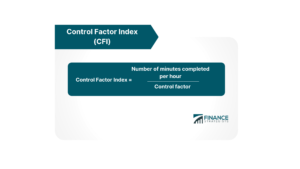The OCU is used when outputs and/or throughput can be measured and the Control-Factor is used to calculate the cost of effort. Control-factor units (CFUs) should be used to rate the relative average amount of time spent on various activities by one staff member in a given period, for example, an hour. CFUs help benchmark activities against one another because the Control-Factor is standardized so that comparisons can be made across different levels of effort involving different types of staff or groups within a profession. It is used to measure work intensity and performance, which enables managers to compare the relative effort spent by different employees and to plan work schedules. Control-factor units can also be used to standardize staff tasks in a way that makes them comparable across different people, periods, or organizations. Control-factor units can be used to identify and correct poor performance because Control Factor units’ values are standardized across various types of work. Do not adequately measure the differences in work done by different individuals because it is standardized. The Control-Factor Units may become obsolete due to changes in wage levels, technology, and/or the organization’s production process. Before any Control-Factor Units or even Control Factor Index is used it must be reviewed by Human Resources and Professional specialties to ensure validity. If the Control-factor index is higher than 1.5 then you should consider revising your unit rate for that task. Control factor units should not be used when output can be measured instead of effort or time.Control-Factor Unit (CFU) Definition
When to Use a Control-Factor Unit?
Control-Factor units can be used for measuring and comparing the work intensities of different professions or groups within one profession, and also between organizations, and for doing different forms of cost comparisons. How Does the Control-Factor Work?

Common Control-Factors Used Are:
Types of Control-Factor Units (CFU)
1. Regular Control Factor (RCF) Units
The RCF is used when outputs cannot be measured and time is the only practical way of quantifying effort. 2. Output Control Units
3. Machine Control Units
The MCU is used for work that can be completely standardized and requires little or no professional judgment, such as processing each transaction in an automated system by inserting a card into a machine.Benefits of Using Control-Factor Unit(s)
Drawbacks of Control-Factor Units
Conclusion
Control-Factor Unit FAQs
A Control-Factor Unit (CFU) is an automated unit designed to maintain steady and controlled temperatures and other environmental conditions, such as humidity levels, in order to provide a stable environment for experiments or other activities.
A CFU uses sensors and controllers to monitor the environment and make adjustments as needed in order to maintain a given set of parameters within an acceptable range. These adjustments may include heating, cooling, or circulating air, controlling humidity levels, or regulating other factors such as light intensity or pressure.
CFUs are commonly used for a wide variety of laboratory and industrial applications, such as in pharmaceutical production, food and beverage processing, and biotechnological experiments. They are also used to maintain the necessary environment for precise manufacturing processes or assembly operations.
CFUs provide an effective and efficient way to maintain stable environmental conditions, allowing for greater accuracy and consistency in the results of experiments or production processes. They also reduce the need for manual intervention and allow for better control over energy usage.
One potential drawback is that CFUs require regular maintenance to ensure that they are functioning properly and the settings are correct. Additionally, the cost of running a CFU can be significant depending on its size and power requirements. Finally, there is always the potential for malfunction or failure due to technical or mechanical issues.
True Tamplin is a published author, public speaker, CEO of UpDigital, and founder of Finance Strategists.
True is a Certified Educator in Personal Finance (CEPF®), author of The Handy Financial Ratios Guide, a member of the Society for Advancing Business Editing and Writing, contributes to his financial education site, Finance Strategists, and has spoken to various financial communities such as the CFA Institute, as well as university students like his Alma mater, Biola University, where he received a bachelor of science in business and data analytics.
To learn more about True, visit his personal website or view his author profiles on Amazon, Nasdaq and Forbes.











